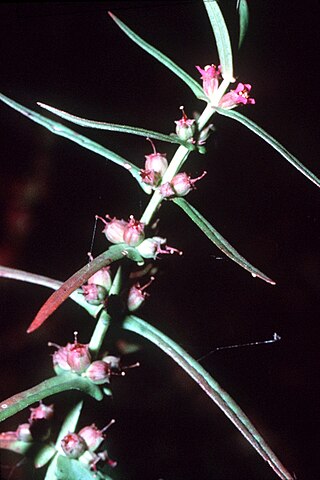
The genus Cajanus is a member of the plant family Fabaceae. There are 37 species, mainly distributed across Africa, Asia and Australasia.

Calophyllum is a genus of tropical flowering plants in the family Calophyllaceae. They are mainly distributed in Asia, with some species in Africa, the Americas, Australasia, and the Pacific Islands.

Terminalia is a genus of large trees of the flowering plant family Combretaceae, comprising nearly 300 species distributed in tropical regions of the world. The genus name derives from the Latin word terminus, referring to the fact that the leaves appear at the very tips of the shoots.

Tephrosia is a genus of flowering plants in the family Fabaceae. It is widespread in both the Eastern and Western Hemisphere, where it is found in tropical and warm-temperate regions.

Capparis is a genus of flowering plants in the family Capparaceae. It includes 142 species of shrubs or lianas which are collectively known as caper shrubs or caperbushes. Capparis species occur over a wide range of habitat in the subtropical and tropical regions of Africa, Eurasia, Australasia, and the Pacific.

Ammannia is a genus of around 100 species of plants often referred to as redstems from wet areas in America, Africa, Asia, Australia and Europe. Several species are grown as decorative plants in aquariums.

Flemingia is a genus of plants in the family Fabaceae. It is native sub-Saharan Africa, Yemen, tropical Asia, and Australasia. In Asia the species are distributed in Bhutan, Burma, China, India; Indonesia, Laos, Malaysia, Nepal, Pakistan, Papua New Guinea, Philippines, Sri Lanka, Taiwan, Thailand and Vietnam. The genus was erected in 1812.

Galactia is a genus of plants in the legume family (Fabaceae). It belongs to the subfamily Faboideae and tribe Diocleae They do not have an unambiguous common name, being commonly called milk peas, beach peas or wild peas. They are perennial herbs or subshrubs with prostrate, climbing, or erect forms.
Hedyotis (starviolet) is a genus of flowering plants in the family Rubiaceae. Many species of this genus such as Hedyotis biflora, H. corymbosa and H. diffusa are well known medicinal plants. Hedyotis is native to tropical and subtropical Asia and to islands of the northwest Pacific. It comprises about 115 species. The type species for the genus is Hedyotis fruticosa.

Mezoneuron is a genus of flowering plants in the legume family, Fabaceae. It belongs to the subfamily Caesalpinioideae and the tribe Caesalpinieae.










